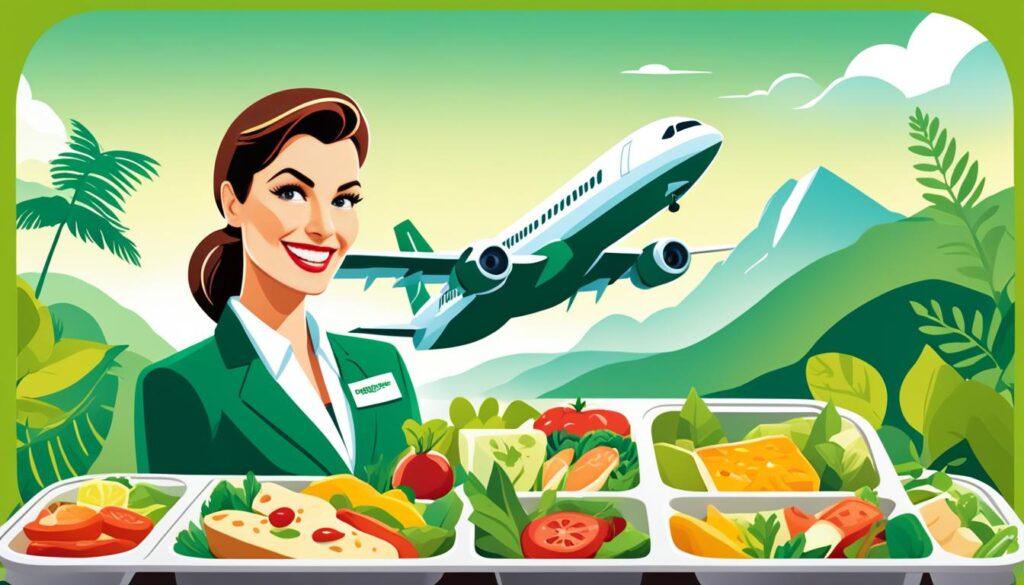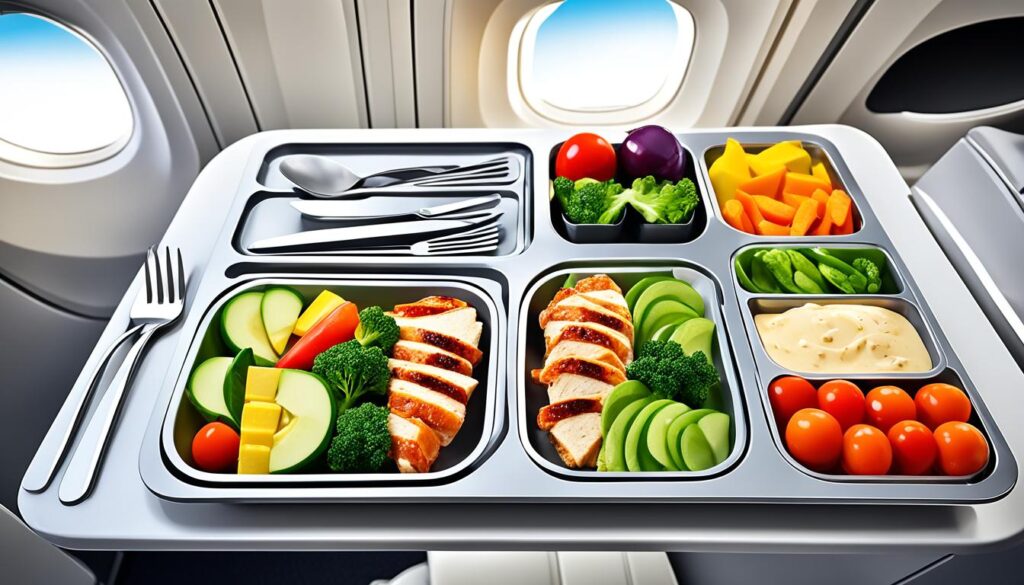The world of aviation catering trends is changing fast, with a growth rate of 8.0% each year from 2023 to 2024. This growth is thanks to more people flying due to higher incomes. It’s making people want better on-the-go food service and in-flight dining experiences. North America leads the market, showing how much people value quality and convenience in the sky.
Partner In Convenience Food is leading the way in making these dining services better. The World Travel Catering & Onboard Services Expo (WTCE) saw a 15% increase in attendance. This shows more people are getting into the sector. The WTCE Connect platform helped set up over 1,400 meetings, showing the industry’s strength and the role of networks in its growth.
The market is expected to grow to $18.33 billion by 2024. Big names like Korean Air Catering Co. Ltd., Japan Airlines Catering Service Co. Ltd., and Emirates Flight Catering LLC are driving this growth. Also, companies like Newrest are expanding and improving the quality of aviation catering trends we’ll see.
Looking ahead to 2024, we’re seeing a blend of fine dining and new technology. This mix is changing aviation catering trends for the better. It’s making on-the-go food service and in-flight dining experiences more exciting, with lots of new ideas coming our way.
Revolutionizing Air Travel: The Growth of Partner In Convenience Food
The demand for convenient food supplier services has soared, making the in-flight market worth USD 9.21 billion. It’s expected to grow even more by 2028. This shows how much travelers now value convenience and quality. Now, air travelers can find meals that fit their diets, like vegan and gluten-free options.
Companies in Convenience Food are leading the change in airplane dining. They work with famous chefs to make sure meals in the sky are delicious. This mix of great food and ready-to-eat meals distributor skills offers a dining experience like at top restaurants on the ground.
Convenient snack partner firms add to this change by offering meals that reflect global tastes. They make flying more enjoyable by adding variety and cultural flavors to meals. This makes eating on a plane a highlight of the trip, not just a basic need.
The future of in-flight dining is all about including everyone and celebrating flavor. Thanks to the creativity of convenient food suppliers and partners, travelers can expect better choices. These changes make flying more enjoyable, turning meals in the air into a key part of the journey. Airlines are making dining above the clouds a memorable part of flying.
Innovations in Meal Preparation and Automation
The inflight catering market is changing fast with new tech like AI in meal prep and automated delivery. These changes make things run smoother and improve what customers get to eat in the air. Automation is making flying meals better and more convenient for everyone.
AI has brought smart kitchens to life, where Kitchen Display Systems (KDS) make ordering and preparing meals faster and more accurate. These systems cut down on mistakes and make sure every meal tastes the same. They also help keep track of ingredients and reduce waste, which is good for the planet and saves money.
Robots are now helping with meal prep, making things more efficient and keeping food quality high. Automated systems for delivering meals are also being tested, like using robots and drones. This could change how we get our meals on flights, making it quicker and more satisfying for everyone.
Digital payments and AI are making buying food on flights smoother and more personal. Airlines can now offer meals that fit what each passenger likes best. With these new tools, AI and automated delivery are key to making flying meals better, offering more convenience and quality in the air.
Health Trends Transforming In-Flight Menus
The world of air travel is changing, with a big focus on healthier meal options. This change reflects a wider move towards wellness and nutrition. Airlines are now working to meet the needs of passengers who want nutritional quick meal solutions.
At the heart of this change are partnerships between airlines and ingredient sourcing specialists. These experts help create meals that are both tasty and healthy. They use fresh, local, and organic produce to make meals that are good for the planet and for our health.
Now, airlines are using technology to offer meals that fit what each passenger wants. Whether you’re on a special diet, like keto, vegan, or gluten-free, there are options for you. This makes flying more enjoyable and shows that airlines care about health.
Airlines are also making it easier to get meals that fit your health goals. With pre-ordered meals, you can get a meal that suits your diet. This makes flying better for everyone, combining convenience with quality and health.
This shows that airlines are more than just a way to get from one place to another. They’re now about making your journey better. By offering healthier meal options, they’re changing what flying means. It’s all thanks to the work of ingredient sourcing specialists.
The Push Towards Sustainable and Eco-Friendly Catering
The aviation industry is changing fast, thanks to consumer awareness. Now, there’s a big push towards sustainable inflight catering and eco-friendly packaging. A Kerry report found that 49% of people worldwide care about sustainability when buying food and drinks. This is making airlines and grab-and-go food suppliers work harder to be more green.
One big change is in packaging. Airlines are now using biodegradable and recyclable materials because 79% of passengers like it. Supply chain experts also put a high priority on sustainable packaging. Plus, 62% of consumers say they’re willing to pay more for products in eco-friendly packaging.
Airlines are adding more non-meat options to their menus to please eco-conscious travelers. This can cut down on greenhouse gas emissions. They’re also using local ingredients to reduce transportation pollution and waste. These steps help airlines meet green standards and attract travelers who care about the planet.
Technology is key in making these sustainable changes work. Apps help track food waste, and systems cut down on carbon emissions. In fact, 64% of companies are using these tech tools. Even though there are challenges like high costs and rules, the push for sustainability is strong and growing.

The move towards sustainable inflight catering, with eco-friendly packaging and responsible sourcing, is a big deal for the aviation world. It shows a big shift towards caring for the environment. This change is in line with today’s values, showing that being green is the future in the skies.
Personalized Catering Experience Takes Center Stage
The aviation industry is changing, and so is how catering works on flights. Airlines now focus on personalized inflight dining. This means passengers get meals that fit their diet and likes. It makes flying better and makes people more loyal to the airline.
Airlines use pre-order meal service to meet passenger tastes. Passengers can pick their meals before flying. This has led to a 25% jump in requests for customized meals, showing people like this approach.
Airlines also offer customized easy meal options. These meals are simple but made to fit what passengers want. It makes flying more enjoyable for everyone, especially those with special diets or who want quick, tasty meals.
Digital tech has helped make these personalized meals possible. With digital menus and easy customization, passengers can pick their meals easily. This makes sure everyone gets a meal they like, making flying better for everyone.
Flights are moving from standard meals to meals made just for you. This change shows how customers want services that fit their needs. Airlines that offer these personalized services get better reviews and more customers.
Emergence of Special Diet and Lifestyle-Centric Meals
Today, more people are flying, and airlines are changing to meet their needs. They now offer vegan inflight meals, gluten-free options, and halal and kosher meals. This shows a big move towards food that fits different diets.

Airlines now focus on the unique food needs of their passengers. For many, finding meals that fit their diet is crucial. By adding vegan inflight meals, airlines help those who choose plant-based diets. These diets are good for the planet and health.
They also offer gluten-free options for those with gluten issues or celiac disease. This makes flying safer and more comfortable for them. And, they have halal and kosher meals too. This respects the beliefs of passengers, making air travel more welcoming for everyone.
These changes are not just about being inclusive. They also reflect a growing focus on health among travelers. People want diet-friendly airline food that fits their health goals. Airlines are listening, offering meals that are not only for special diets but also good for the planet and health.
Airlines are adapting to what global travelers want, making vegan inflight meals, gluten-free options, and halal and kosher meals key in their menus. This change shows how society values personal choices and health. It makes flying better for everyone, meeting their dietary needs.
Collaboration with Local Chefs and Culinary Experts
The airline industry is now seeing the value of local chef partnerships to change the game for high-quality inflight food. By working with culinary experts, airlines are not just improving their menus. They’re also creating unique dining experiences that show off local tastes and meet global standards.
For instance, My House Events is leading the way by teaming up with various culinary talents in big cities like Los Angeles and New Orleans. This approach doesn’t just make the flying experience better. It also helps local economies by highlighting regional food skills.
Airlines like Singapore Airlines and Lufthansa are at the forefront of this trend. They work with famous local chefs to make menus that let passengers taste the destination before they arrive. This partnership helps everyone: the culinary experts get to show their skills on a global stage, and passengers enjoy top-notch meals in the air.
My House Events also focuses on being inclusive. They don’t charge chefs to join their group, making it open to all. This includes women, BIPOC, and LGBTQ+ chefs. This approach brings in a wide range of culinary talents, making the food more diverse and interesting.
This teamwork leads to a dining experience in the sky that’s more than just eating. It becomes a key part of the trip, setting these airlines ahead in making customers happy and bringing new ideas to the table. By working with local chef partnerships, the airline industry not only improves its services. It also boosts its brand and attracts more customers.
Digitization in Catering: Enhanced Ordering and Delivery Systems
The impact of digital ordering systems on inflight catering is amazing. For example, Tarka Indian Kitchen saw a 43% increase in sales after using Checkmate’s tech. This shows how well technology and better dining experiences work together. Now, over 70% of their orders are digital, making things easier for customers.
Inflight catering technology does more than just take orders. It updates menus in real-time, giving customers the latest options. This has made Wendy’s operations smoother, with less labor and rent costs.
Digital ordering systems also make it easy to combine orders from different places into one system. This is what Buffalo Wild Wings does. It makes serving faster and orders more accurate, which makes customers happier. Arby’s uses this tech too, letting more people enjoy their food easily.
Switching to a tech-driven meal service is smart and meets customer needs for ease and quality. With the online food delivery market growing fast, using digital tools is key for catering to succeed. These technologies help make dining on flights better, more efficient, and satisfying for passengers.
Exploring New Horizons: Fusion Cuisine in Aviation
In the world of aviation catering, fusion cuisine shines as a beacon of innovation. It brings exciting tastes from around the world right to passengers’ seats. Airlines are now focusing on making their inflight dining stand out by blending cultural diversity in meals.
The push for international food offerings is more than just adding new dishes to the menu. It’s about creating an experience that matches the diverse tastes of today’s travelers. Airlines are working with top chefs to make menus that mix global flavors. This turns a simple meal into a journey of discovery for passengers.
This trend makes dining in the sky more than just a need—it becomes a highlight of the trip. By offering innovative inflight dining, airlines use fusion cuisine to boost their brand and make passengers happier. As flying becomes more competitive, having meals that show cultural diversity will keep airlines ahead.
So, using fusion cuisine is more than a food strategy. It’s a way to celebrate global cultures and offer a richer experience that fits the changing world of flying.
Conclusion
The future of aviation catering is changing to meet new demands. Industry data shows a big shift in what people want to eat. This change is not just about offering more menu choices. It’s about making passenger satisfaction in inflight services better.
Studies show how lifestyle affects what people buy. For example, the German food study found that household size and job status play a big role. This shows how complex consumer choices can be.
Aviation catering leaders see the big role of convenience in our daily food choices. Studies show a move towards convenience, not just a trend. This change matches big changes in society, like more women working and smaller households.
There’s a focus on making meals easier and more sustainable. This, along with a push for cultural diversity, gives the industry a competitive edge in catering.
Looking ahead, the future looks bright for inflight catering. Airlines are working hard to make flying a great experience. They’re offering a wide range of tasty, personalized, and eco-friendly food options.
This mix of nutrition, food art, and technology will keep making flying meals better. The trends show a promising future for aviation catering. It’s set to meet the changing ways we travel.

